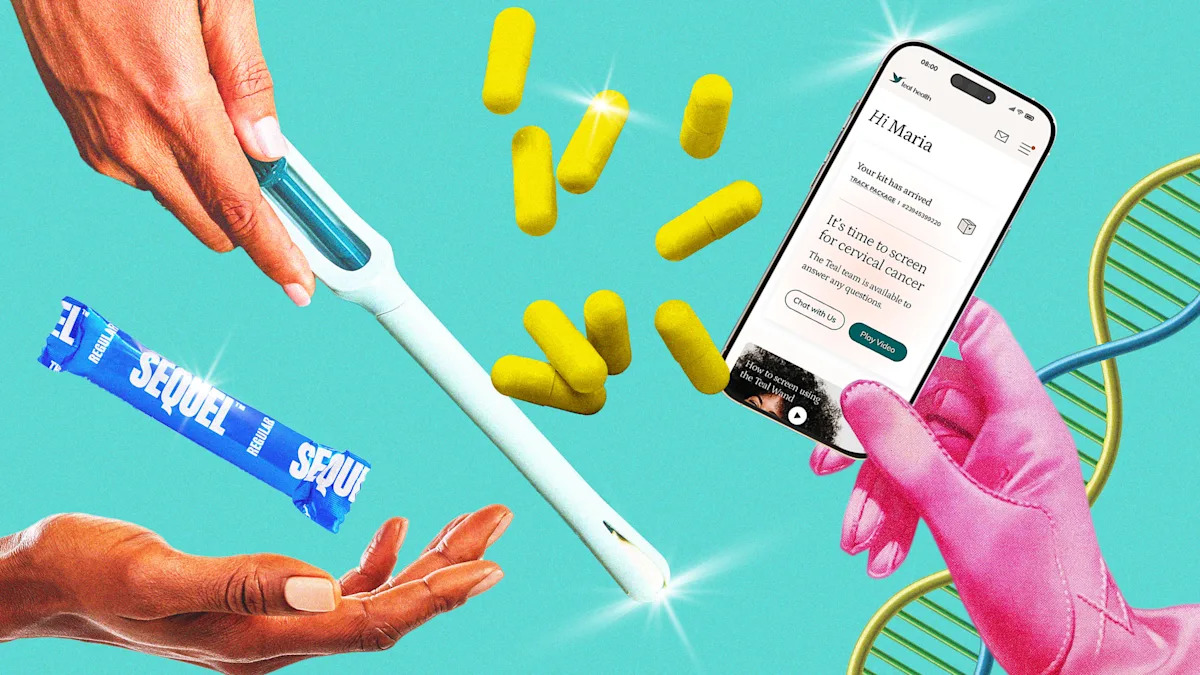
There are so many innovations happening in women’s health right now. (Photo illustration: Yahoo News; photos: Getty Images, Sequel, Teal Health)
A tampon that stops leaks. A cervical cancer screening test you can take at home. An app that tracks perimenopause symptoms to help you sort through the confusion and manage them better. These are just a few of the key innovations that are reshaping women’s health, making it a priority rather than an afterthought. To quote Lizzo: “It’s about damn time.”
It’s well known that women’s health has been historically overlooked and underfunded, while women’s symptoms are often dismissed or misunderstood, creating a gender health gap. A wave of innovations in female-focused technology, aka femtech, is starting to change that, putting women in charge of their own health and breaking down barriers to better care. And not surprisingly, it’s often women, from scientists to CEOs, who are pushing for change — call them problem solveHERs, if you will.
Investors are finally taking notice. Femtech has become a booming industry, with apps, wearable devices and products tracking and managing periods, fertility, menopause and more. The global femtech market is expected to be valued at $60 billion by 2027, according to a report by Emergen Research.
To say it’s a remarkable time in women’s health is an understatement. “Since I have been a doctor, I could count on one hand the number of new treatments and technologies for all of gynecology,” Dr. Karen Tang, a gynecologist and author of It’s Not Hysteria: Everything You Need to Know About Your Reproductive Health (But Were Never Told), tells Yahoo. “There really aren’t a lot of innovations, so having a few of them — like the [at-home] HPV screening and non-invasive tests for endometriosis and [new] classes of medications — is actually really unusual. So it’s exciting to have that. It’s hopefully the start of more innovations to come.”
Dr. Gil Weiss, an ob-gyn at the Association for Women’s Health Care and assistant professor of clinical medicine in the department of obstetrics and gynecology at Northwestern Memorial Hospital in Chicago, agrees. “We are experiencing a new surge in women’s health research, which will help achieve a more inclusive health care system for everyone,” he says.
Here’s a look at some of the cool innovations that are transforming women’s health, what problems they solve and how they work.
Problem: Tampons can leak.
Solution: The new Sequel Spiral tampon’s helix shape prevents leakage and marks the first major change to tampon design in more than 90 years.
Problem: Cervical cancer screenings can save lives, but people skip them for many reasons, from busy schedules to concerns about cost to anxiety over the exam.
Solution: The Teal Wand is an FDA-approved cervical cancer screening tool you can use at home.
Problem: Figuring out if you’re in perimenopause, let alone navigating it and managing symptoms, can be tricky.
Solution: Peri by identifyHer is a wearable device with an app that tracks women’s perimenopausal symptoms and provides personalized advice on how to better manage them.
Problem: Antibiotic-resistant UTIs are making them harder to treat.
Solution: There’s a new antibiotic, gepotidacin (Blujepa), which is the first in a new class of oral antibiotics for UTIs in nearly 30 years.
Problem: It can take up to 11 years to get an endometriosis diagnosis.
Solution: Two cutting-edge products — Qvin’s Q-Pad and NextGen Jane Smart Tampon — are aiming to take the guesswork and long waits out of diagnosing endometriosis and similar reproductive health conditions.






